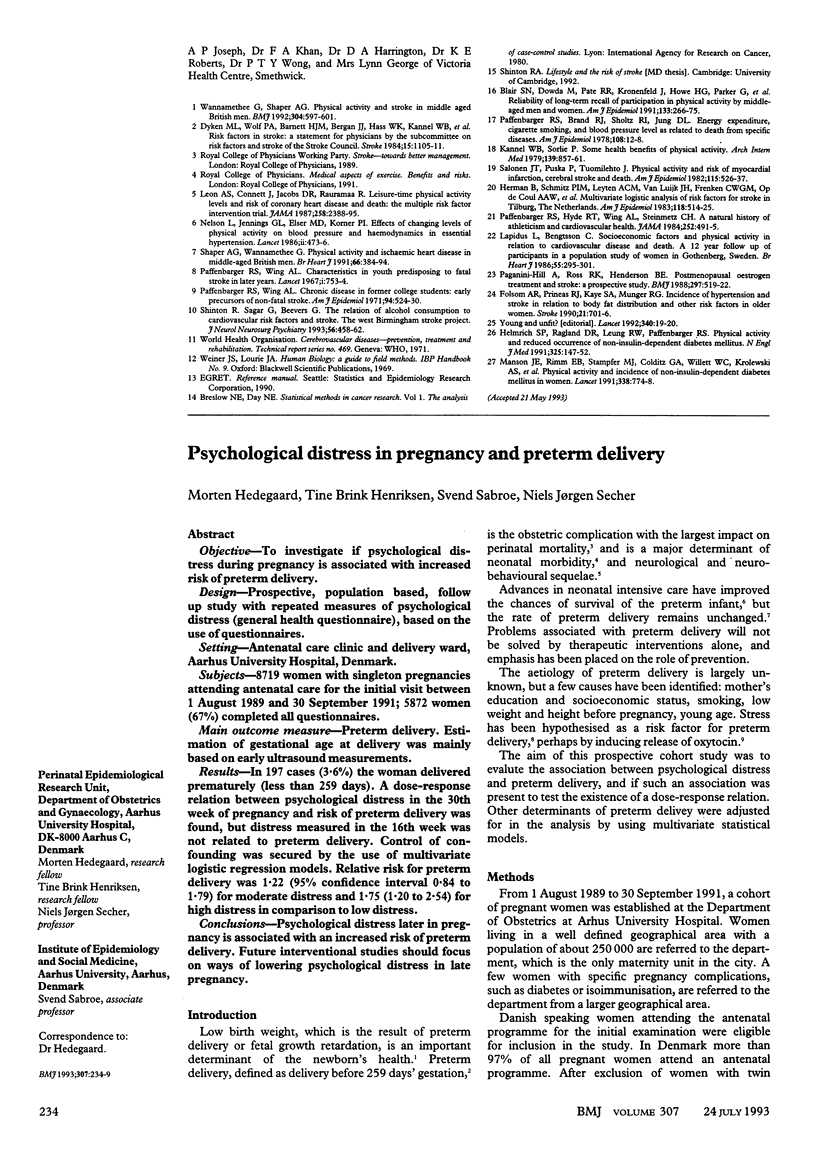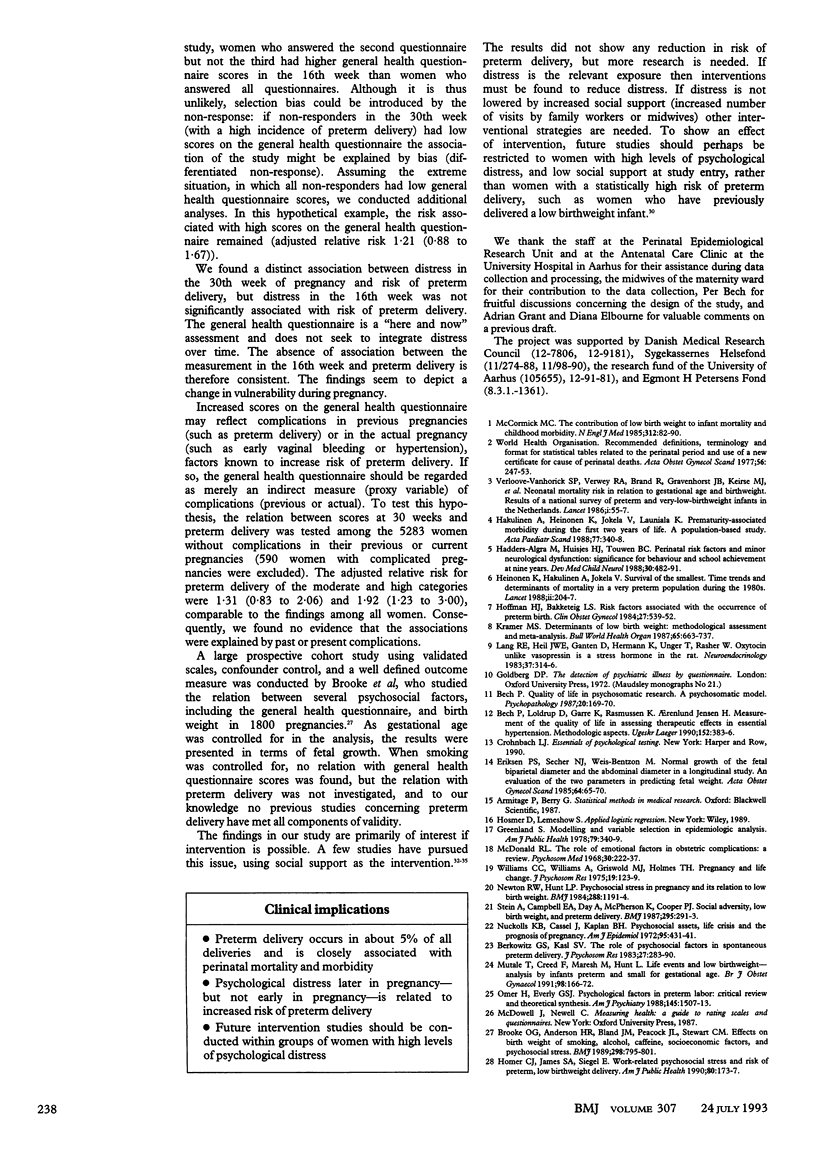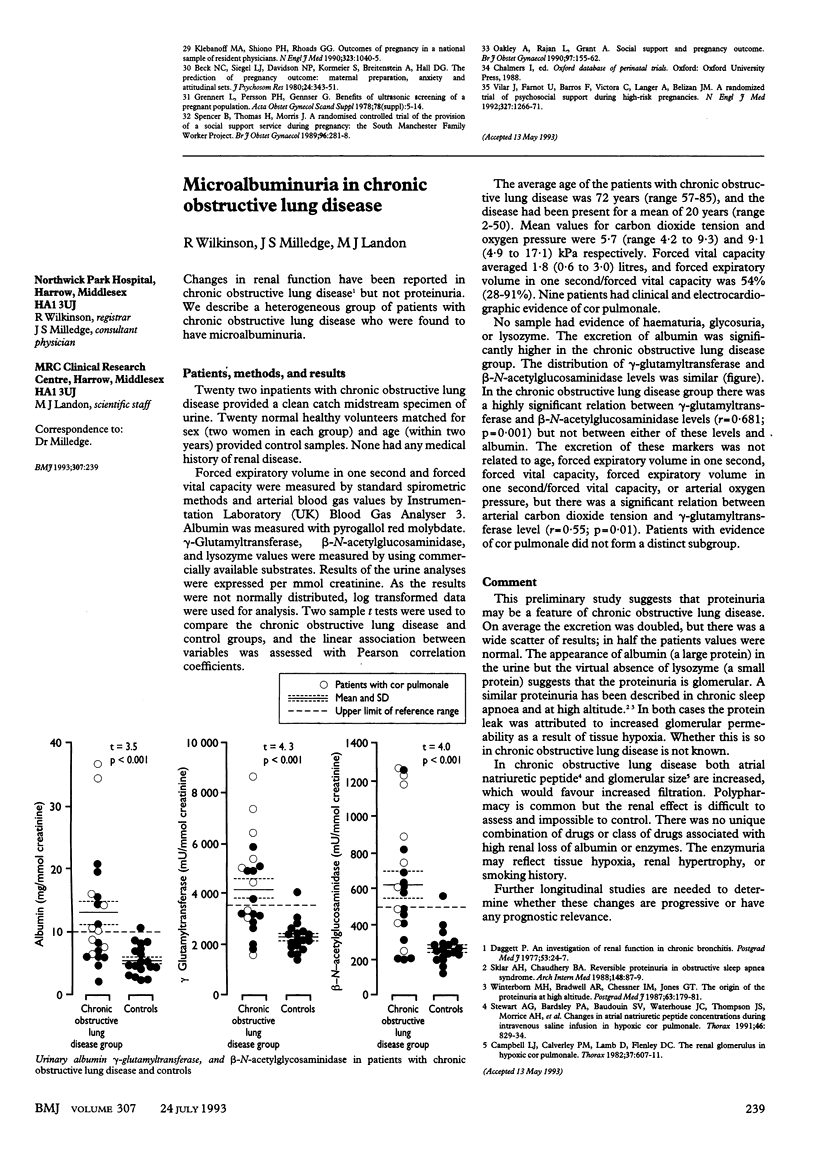Abstract
OBJECTIVE--To investigate if psychological distress during pregnancy is associated with increased risk of preterm delivery. DESIGN--Prospective, population based, follow up study with repeated measures of psychological distress (general health questionnaire), based on the use of questionnaires. SETTING--Antenatal care clinic and delivery ward, Aarhus University Hospital, Denmark. SUBJECTS--8719 women with singleton pregnancies attending antenatal care for the initial visit between 1 August 1989 and 30 September 1991; 5872 women (67%) completed all questionnaires. MAIN OUTCOME MEASURE--Preterm delivery. Estimation of gestational age at delivery was mainly based on early ultrasound measurements. RESULTS--In 197 cases (3.6%) the woman delivered prematurely (less than 259 days). A dose-response relation between psychological distress in the 30th week of pregnancy and risk of preterm delivery was found, but distress measured in the 16th week was not related to preterm delivery. Control of confounding was secured by the use of multivariate logistic regression models. Relative risk for preterm delivery was 1.22 (95% confidence interval 0.84 to 1.79) for moderate distress and 1.75 (1.20 to 2.54) for high distress in comparison to low distress. CONCLUSIONS--Psychological distress later in pregnancy is associated with an increased risk of preterm delivery. Future interventional studies should focus on ways of lowering psychological distress in late pregnancy.
Full text
PDF





Selected References
These references are in PubMed. This may not be the complete list of references from this article.
- Bech P. Quality of life in psychosomatic research. A psychometric model. Psychopathology. 1987;20(3-4):169–179. doi: 10.1159/000284496. [DOI] [PubMed] [Google Scholar]
- Beck N. C., Siegel L. J., Davidson N. P., Kormeier S., Breitenstein A., Hall D. G. The prediction of pregnancy outcome: maternal preparation, anxiety and attitudinal sets. J Psychosom Res. 1980;24(6):343–351. doi: 10.1016/0022-3999(80)90026-4. [DOI] [PubMed] [Google Scholar]
- Berkowitz G. S., Kasl S. V. The role of psychosocial factors in spontaneous preterm delivery. J Psychosom Res. 1983;27(4):283–290. doi: 10.1016/0022-3999(83)90050-8. [DOI] [PubMed] [Google Scholar]
- Brooke O. G., Anderson H. R., Bland J. M., Peacock J. L., Stewart C. M. Effects on birth weight of smoking, alcohol, caffeine, socioeconomic factors, and psychosocial stress. BMJ. 1989 Mar 25;298(6676):795–801. doi: 10.1136/bmj.298.6676.795. [DOI] [PMC free article] [PubMed] [Google Scholar]
- Eriksen P. S., Secher N. J., Weis-Bentzon M. Normal growth of the fetal biparietal diameter and the abdominal diameter in a longitudinal study. An evaluation of the two parameters in predicting fetal weight. Acta Obstet Gynecol Scand. 1985;64(1):65–70. doi: 10.3109/00016348509154690. [DOI] [PubMed] [Google Scholar]
- Greenland S. Modeling and variable selection in epidemiologic analysis. Am J Public Health. 1989 Mar;79(3):340–349. doi: 10.2105/ajph.79.3.340. [DOI] [PMC free article] [PubMed] [Google Scholar]
- Grennert L., Persson P. H., Gennser G. Benefits of ultrasonic screening of a pregnant population. Acta Obstet Gynecol Scand Suppl. 1978;78:5–14. doi: 10.3109/00016347809162696. [DOI] [PubMed] [Google Scholar]
- Hadders-Algra M., Huisjes H. J., Touwen B. C. Perinatal risk factors and minor neurological dysfunction: significance for behaviour and school achievement at nine years. Dev Med Child Neurol. 1988 Aug;30(4):482–491. doi: 10.1111/j.1469-8749.1988.tb04775.x. [DOI] [PubMed] [Google Scholar]
- Hakulinen A., Heinonen K., Jokela V., Launiala K. Prematurity-associated morbidity during the first two years of life. A population-based study. Acta Paediatr Scand. 1988 May;77(3):340–348. doi: 10.1111/j.1651-2227.1988.tb10658.x. [DOI] [PubMed] [Google Scholar]
- Heinonen K., Hakulinen A., Jokela V. Survival of the smallest. Time trends and determinants of mortality in a very preterm population during the 1980s. Lancet. 1988 Jul 23;2(8604):204–207. doi: 10.1016/s0140-6736(88)92300-8. [DOI] [PubMed] [Google Scholar]
- Hoffman H. J., Bakketeig L. S. Risk factors associated with the occurrence of preterm birth. Clin Obstet Gynecol. 1984 Sep;27(3):539–552. doi: 10.1097/00003081-198409000-00004. [DOI] [PubMed] [Google Scholar]
- Homer C. J., James S. A., Siegel E. Work-related psychosocial stress and risk of preterm, low birthweight delivery. Am J Public Health. 1990 Feb;80(2):173–177. doi: 10.2105/ajph.80.2.173. [DOI] [PMC free article] [PubMed] [Google Scholar]
- Klebanoff M. A., Shiono P. H., Rhoads G. G. Outcomes of pregnancy in a national sample of resident physicians. N Engl J Med. 1990 Oct 11;323(15):1040–1045. doi: 10.1056/NEJM199010113231506. [DOI] [PubMed] [Google Scholar]
- Kramer M. S. Determinants of low birth weight: methodological assessment and meta-analysis. Bull World Health Organ. 1987;65(5):663–737. [PMC free article] [PubMed] [Google Scholar]
- Lang R. E., Heil J. W., Ganten D., Hermann K., Unger T., Rascher W. Oxytocin unlike vasopressin is a stress hormone in the rat. Neuroendocrinology. 1983 Oct;37(4):314–316. doi: 10.1159/000123566. [DOI] [PubMed] [Google Scholar]
- McCormick M. C. The contribution of low birth weight to infant mortality and childhood morbidity. N Engl J Med. 1985 Jan 10;312(2):82–90. doi: 10.1056/NEJM198501103120204. [DOI] [PubMed] [Google Scholar]
- McDonald R. L. The role of emotional factors in obstetric complications: a review. Psychosom Med. 1968 Mar-Apr;30(2):222–243. doi: 10.1097/00006842-196803000-00007. [DOI] [PubMed] [Google Scholar]
- Mutale T., Creed F., Maresh M., Hunt L. Life events and low birthweight--analysis by infants preterm and small for gestational age. Br J Obstet Gynaecol. 1991 Feb;98(2):166–172. doi: 10.1111/j.1471-0528.1991.tb13363.x. [DOI] [PubMed] [Google Scholar]
- Newton R. W., Hunt L. P. Psychosocial stress in pregnancy and its relation to low birth weight. Br Med J (Clin Res Ed) 1984 Apr 21;288(6425):1191–1194. doi: 10.1136/bmj.288.6425.1191. [DOI] [PMC free article] [PubMed] [Google Scholar]
- Nuckolls K. B., Kaplan B. H., Cassel J. Psychosocial assets, life crisis and the prognosis of pregnancy. Am J Epidemiol. 1972 May;95(5):431–441. doi: 10.1093/oxfordjournals.aje.a121410. [DOI] [PubMed] [Google Scholar]
- Oakley A., Rajan L., Grant A. Social support and pregnancy outcome. Br J Obstet Gynaecol. 1990 Feb;97(2):155–162. doi: 10.1111/j.1471-0528.1990.tb01741.x. [DOI] [PubMed] [Google Scholar]
- Omer H., Everly G. S., Jr Psychological factors in preterm labor: critical review and theoretical synthesis. Am J Psychiatry. 1988 Dec;145(12):1507–1513. doi: 10.1176/ajp.145.12.1507. [DOI] [PubMed] [Google Scholar]
- Spencer B., Thomas H., Morris J. A randomized controlled trial of the provision of a social support service during pregnancy: the South Manchester Family Worker Project. Br J Obstet Gynaecol. 1989 Mar;96(3):281–288. doi: 10.1111/j.1471-0528.1989.tb02387.x. [DOI] [PubMed] [Google Scholar]
- Stein A., Campbell E. A., Day A., McPherson K., Cooper P. J. Social adversity, low birth weight, and preterm delivery. Br Med J (Clin Res Ed) 1987 Aug 1;295(6593):291–293. doi: 10.1136/bmj.295.6593.291. [DOI] [PMC free article] [PubMed] [Google Scholar]
- Verloove-Vanhorick S. P., Verwey R. A., Brand R., Gravenhorst J. B., Keirse M. J., Ruys J. H. Neonatal mortality risk in relation to gestational age and birthweight. Results of a national survey of preterm and very-low-birthweight infants in the Netherlands. Lancet. 1986 Jan 11;1(8472):55–57. doi: 10.1016/s0140-6736(86)90713-0. [DOI] [PubMed] [Google Scholar]
- Villar J., Farnot U., Barros F., Victora C., Langer A., Belizan J. M. A randomized trial of psychosocial support during high-risk pregnancies. The Latin American Network for Perinatal and Reproductive Research. N Engl J Med. 1992 Oct 29;327(18):1266–1271. doi: 10.1056/NEJM199210293271803. [DOI] [PubMed] [Google Scholar]
- Williams C. C., Williams A., Griswold M. J., Holmes T. H. Pregnancy and life change. J Psychosom Res. 1975 Apr;19(2):123–129. doi: 10.1016/0022-3999(75)90059-8. [DOI] [PubMed] [Google Scholar]


